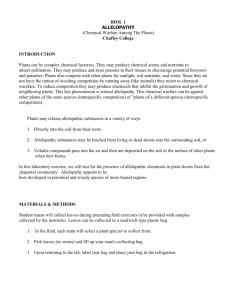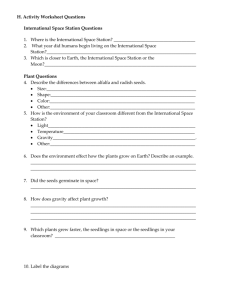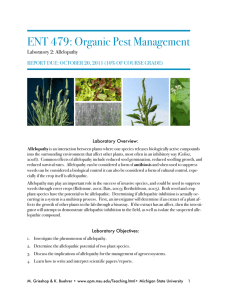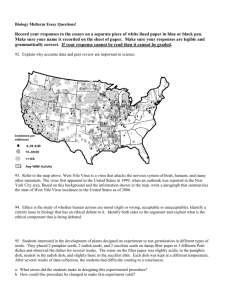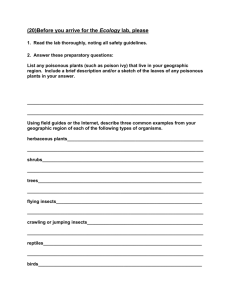Involving Your Students in Cutting
advertisement
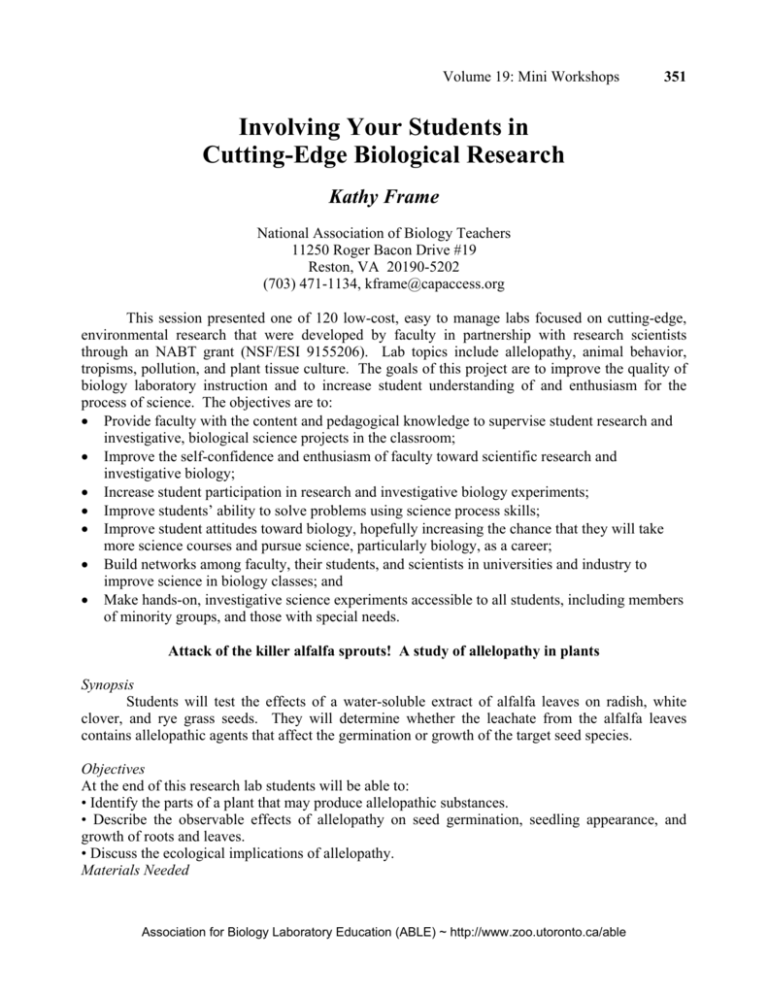
Volume 19: Mini Workshops 351 Involving Your Students in Cutting-Edge Biological Research Kathy Frame National Association of Biology Teachers 11250 Roger Bacon Drive #19 Reston, VA 20190-5202 (703) 471-1134, kframe@capaccess.org This session presented one of 120 low-cost, easy to manage labs focused on cutting-edge, environmental research that were developed by faculty in partnership with research scientists through an NABT grant (NSF/ESI 9155206). Lab topics include allelopathy, animal behavior, tropisms, pollution, and plant tissue culture. The goals of this project are to improve the quality of biology laboratory instruction and to increase student understanding of and enthusiasm for the process of science. The objectives are to: • Provide faculty with the content and pedagogical knowledge to supervise student research and investigative, biological science projects in the classroom; • Improve the self-confidence and enthusiasm of faculty toward scientific research and investigative biology; • Increase student participation in research and investigative biology experiments; • Improve students’ ability to solve problems using science process skills; • Improve student attitudes toward biology, hopefully increasing the chance that they will take more science courses and pursue science, particularly biology, as a career; • Build networks among faculty, their students, and scientists in universities and industry to improve science in biology classes; and • Make hands-on, investigative science experiments accessible to all students, including members of minority groups, and those with special needs. Attack of the killer alfalfa sprouts! A study of allelopathy in plants Synopsis Students will test the effects of a water-soluble extract of alfalfa leaves on radish, white clover, and rye grass seeds. They will determine whether the leachate from the alfalfa leaves contains allelopathic agents that affect the germination or growth of the target seed species. Objectives At the end of this research lab students will be able to: • Identify the parts of a plant that may produce allelopathic substances. • Describe the observable effects of allelopathy on seed germination, seedling appearance, and growth of roots and leaves. • Discuss the ecological implications of allelopathy. Materials Needed Association for Biology Laboratory Education (ABLE) ~ http://www.zoo.utoronto.ca/able 352 Volume 19: Mini Workshops For the teacher preparation, you will need the following for a class of 24 students: • 2 shallow plastic planting trays (30 x 60 cm) • topsoil or potting soil • 100 g alfalfa seeds For the core experiment, you will need the following per team of 4 students: • 5 g freshly cut alfalfa leaves • 1 150-mL glass beaker • 18 disposable Petri dishes, 10 x 150 mm • 1 permanent marking pen • 54 sheets of 8-cm Whatman filter paper • 60 seeds each of radish, white clover, and rye grass • 1 50-mL flask • 2 5-mL disposable plastic pipettes or syringes without needles For the core experiment, you will need the following per class of 24 students: • 4 L distilled water • cheese cloth Preparation Time Required Allow approximately 30 minutes for planting the alfalfa and setting out the students' supplies. Directions for Setting Up the Experiment Alfalfa: Purchase alfalfa sprouts from the grocer to make the tea. OR Planting the Alfalfa: 1. Weigh out approximately 50 g of alfalfa seeds for each of the plastic planting flats. Plant the seeds by spreading them evenly across the soil surface and covering them with about 1 cm of soil. 2. Water the seeds thoroughly and place them in a well-lit area. 3. Continue to water as needed to keep the soil moist. 4. Expect sprouting in 3-5 days. The alfalfa will be ready to harvest within 10-15 days. The plants should have 16 hours of daylight for optimal growth. Artificial lights with timers can be used to supplement natural light, if necessary. Teacher Background Content Information Ecology is the study of interactions between organisms and their environment. One type of interaction frequently studied by ecologists is the competition between two or more species for limited resources. When a resource, such as water, is in limited supply, those species that need it will compete for it. Competition is defined as one individual securing access to a resource in a way that restricts the access of other individuals. Competition can occur between individuals of the same species (intraspecific) or of different species (interspecific). One possible result of competition is the Volume 19: Mini Workshops 353 extinction of a species. The Russian biologist G.F. Gause (1934) demonstrated this possibility with two species of Paramecium. When grown together in a laboratory culture, one species always became extinct, even though each species grew well alone. Another possible outcome of competition is specialization of each species in their use of resources. As this happens, their resource requirements no longer overlap entirely and they are able to coexist in the same environment. Competition between species can be an important factor influencing the distributions and evolution of species. There are two general ways an organism can limit the resources available to another organism- exploitation or interference. In exploitation competition, one species is better adapted for using the limited resource. This indirectly deprives the other species of the resource. An example is a desert plant that has an extensive root system allowing it to use water that would otherwise be available to another plant species. The second type of competition, interference, occurs when one species directly prevents the other from using the resource by either physical or chemical means. Allelopathy is a form of chemical interference competition utilized by plants. The word “allelopathy” is derived from the root words allelon, "of each other," and pathos, "to suffer." Allelopathy involves a chemical inhibition of one species by another. Biomolecules produced by one plant, mostly secondary metabolites, are released into the environment and then affect the growth and development of neighboring plants. In California's Mojave Desert, for example, creosote shrubs exclude burro-weed by exuding a chemical from their roots. This chemical inhibits the root growth of the burro-weed. Allelopathic chemicals may be present in any part of a plant including the leaves, flowers, fruits, stems, roots, rhizomes, and seeds. These toxins can affect a target species in a number of ways. For example, they may inhibit the target species' nutrient uptake or they may inhibit shoot or root growth. Some plants, such as clover, have a symbiotic or mutually beneficial relationship with nitrogen-fixing bacteria that provide nitrogen for the plants' growth. An allelopathic agent against clover might directly attack the symbiotic bacteria and destroy the plant's source of usable nitrogen. Allelopathy is not a recent discovery. In 300 BC, Theophrastus realized that planting chick peas made the soil unsuitable for many other plants. Earlier records of allelopathy date back before 300 BC when Democritus reported that weeds could be controlled by using naturally occurring plant products and trees could be killed by treating their roots with a mixture of lupine flowers soaked in hemlock juice. In 1 AD, Pliny, the Roman naturalist, reported that barley and bitter vetch prevented the growth of other plants in the same soil (Latto and Wright, 1995). Later reports showed that even the rain or dew washing from pine needles onto crop plants caused damage. Some researchers, however, contend that other factors, such as competition for light or nutrients, are the reason why certain plants are unable to grow together and that allelopathy is not a factor. Instructional Procedures for the Core Experiment Introduction Start by brewing a pot of tea to help introduce allelopathy. Ask the students what is creating the smell and color in the tea and then let them taste the tea. Relate the smell and taste to the chemicals in the tea plant, such as tannin. Association for Biology Laboratory Education (ABLE) ~ http://www.zoo.utoronto.ca/able 354 Volume 19: Mini Workshops Have some potted herbs such as mint or pennyroyal for students to rub between their fingers. Discuss the presence of chemicals that are responsible for these odors. Freshly cut pine boughs also work well to illustrate the point that plants contain many chemicals. Discus the botanical origin of many of our modern medicines. Some of these medicinal substances are derived from common plants and trees that the students may have growing in their own backyards. An example is foxglove (Digitalis), which is the source of a drug used to treat some heart conditions. One of the reasons for the preservation of the tropical rain forests is the potential for the discovery of valuable medicines. Not all substances that plants produce are useful as medicines; many are toxins. Some chemicals produced by plants serve as defenses against predators by making the plant distasteful or toxic. The oils produced by poison ivy are a good example of this. Even the medicinal chemical extracted from foxglove is toxic in larger doses. Remind the students that allelopathic substances are not just found in the leaves, but may also be present in other parts of the plant, like the roots, stems and flowers. Discuss allelopathy as a form of interference competition and relate it to broader ecological and evolutionary principles. You could also mention the practical human applications related to agriculture. Below is a sample hypothesis, procedure and data analysis set with interpretation that students might develop for the Core Experiment. This example has been included as a potential outcome of the activity and should not be given to the students. Students should develop their own hypotheses and procedures. Make sure they understand that there is not just one correct hypothesis, procedure, or data set. Hypothesis for the Core Experiment The leaf extract from alfalfa will have a negative effect on the germination and seedling height of radish, white clover, and rye grass seeds. Procedure Day 1 1. Harvest 5 g of alfalfa shoots by cutting them close to the soil surface. 2. Remove any loose soil from the shoots. 3. Place the alfalfa shoots in a large beaker and add 25 mL of distilled water. Press the shoots down so they are totally submerged and cover the beaker to prevent evaporation. Let the alfalfa shoot "tea" steep for 2 days. 4. Label 18 Petri dishes with the following information: • dish number • treatment (alfalfa extract) or control (distilled water) • type of seed (radish, white clover, or rye grass) Day 3 5. Pour the alfalfa-leaf extract through several layers of cheesecloth to remove any suspended matter and collect the liquid in a flask. This extract will be used to treat the seeds. 6. Line each Petri dish with 3 sheets of filter paper. Volume 19: Mini Workshops 355 7. Add 5 mL of distilled water to each of the control dishes. 8. Add 5 mL of leaf extract to each of the treatment dishes. 9. Place 10 radish seeds in each of the 3 control Petri dishes and the 3 experimental Petri dishes. Spread the seeds evenly in the dish and cover with the lid. 10. Repeat step 9 using the white clover and the rye grass seeds. 11. Place all of the Petri dishes in a warm, well-lit place. Days 5, 7 and 9 12. Record the number of germinated seeds and descriptions of each seedling's appearance. 13. On the final day, also measure the shoot and root length of each seedling. References Anonymous. 1983. Killer plants: Getting plants to turn on each other. The Economist, 287 (7290): 104. Cox, P.A. and M.J Balick. 1994. The ethnobotanical approach to drug discovery. Scientific American, 270(6): 82-87. Dutton, G. 1993. Yo Buddy--Outa My Space! American Horticulturist, 72(3): 5-6. Gause, G. F. 1934. The struggle for existence. Williams and Wilkins, Baltimore, Maryland, 163 pages. A reprint of the 1934 edition was published in 1971. Dover Publications, New York, 163 pages. [ISBN 0-48-22697-2] Kozlov, A. 1991. Weed woes. Discover, 11: 24. Latto, J. and H. Wright. 1995. Allelopathy in seeds. Journal of Biological Education, 29(2): 123128. Massey, A.B. 1925. Antagonism of the walnuts (Juglans nigra L. and J. cinerea L.) in certain plant associations. Phytopathology, 15: 773-784. Piper, K. 1992. The seedy side of sunflowers. Horticulture, 70 (10): 24. Ricklefs, R.E. 1990. Ecology, 3rd ed. W. H. Freeman and Company, New York, 896 pages. [ISBN 0-71-672077-9] Weiss, R. 1991. Root words. Science News, 139(10): 188-189. Reprinted From: Frame, K. 1998. Involving your students in cutting-edge biological research. Pages 351355, in Tested studies for laboratory teaching, Volume 19 (S. J. Karcher, Editor). Proceedings of the 19th Workshop/Conference of the Association for Biology Laboratory Education (ABLE), 365 pages. - Copyright policy: http://www.zoo.utoronto.ca/able/volumes/copyright.htm Although the laboratory exercises in ABLE proceedings volumes have been tested and due consideration has been given to safety, individuals performing these exercises must assume all responsibility for risk. The Association for Biology Laboratory Education (ABLE) disclaims any liability with regards to safety in connection with the use of the exercises in its proceedings volumes. Association for Biology Laboratory Education (ABLE) ~ http://www.zoo.utoronto.ca/able
